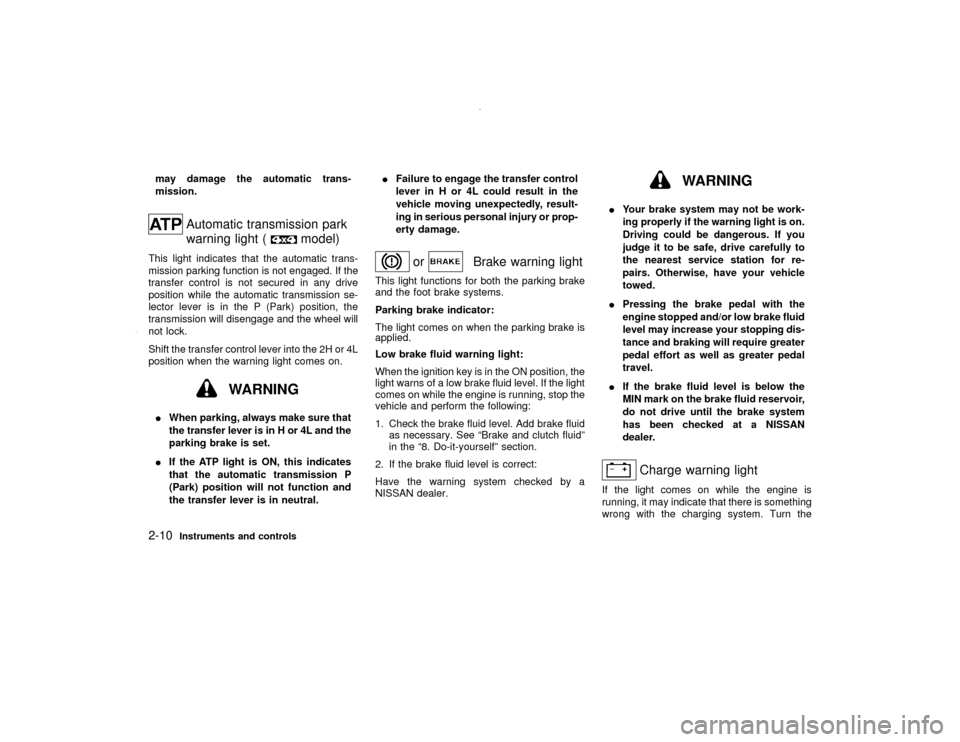2000 NISSAN PATHFINDER tow
[x] Cancel search: towPage 33 of 265

you could be thrown into it and re-
ceive neck or other serious injuries.
You could also slide under the lap
belt and receive serious internal inju-
ries.
IFor most effective protection when
the vehicle is in motion, the seat
should be upright. Always sit well
back in the seat and adjust the seat
belt properly.
Fastening the seat belts1. Adjust the seat.2. Slowly pull the seat belt out of the retractor
and insert the tongue into the buckle until it
snaps.
The retractor is designed to lock during a
sudden stop or on impact. A slow pulling
motion will permit the belt to move, and
allow you some freedom of movement in
the seat.
3. Position the lap belt portionlow and snug
on the hipsas shown.
4. Pull the shoulder belt portion toward the
retractor to take up extra slack.The front seat passenger side seat belt and
rear three-point seat belts have a cinching
mechanism for child restraint installation. It is
referred to as the automatic locking mode.
When the cinching mechanism is activated the
seat belt cannot be withdrawn again until the
seat belt tongue is detached from the buckle
and fully retracted. For additional information,
see ªChild Restraints for Infants and Small
Childrenº later in this section.
The automatic locking mode should be
used only for child restraint installation.
During normal seat belt use by a passen-
ger, the locking mode should not be acti-
SSS0020
SSS0102
SSS0061
1-26
Seats, restraints and supplemental air bag systems
Z
00.1.17/R50-D/V5
X
Page 63 of 265

may damage the automatic trans-
mission.
Automatic transmission park
warning light (
model)
This light indicates that the automatic trans-
mission parking function is not engaged. If the
transfer control is not secured in any drive
position while the automatic transmission se-
lector lever is in the P (Park) position, the
transmission will disengage and the wheel will
not lock.
Shift the transfer control lever into the 2H or 4L
position when the warning light comes on.
WARNING
IWhen parking, always make sure that
the transfer lever is in H or 4L and the
parking brake is set.
IIf the ATP light is ON, this indicates
that the automatic transmission P
(Park) position will not function and
the transfer lever is in neutral.IFailure to engage the transfer control
lever in H or 4L could result in the
vehicle moving unexpectedly, result-
ing in serious personal injury or prop-
erty damage.
or
Brake warning light
This light functions for both the parking brake
and the foot brake systems.
Parking brake indicator:
The light comes on when the parking brake is
applied.
Low brake fluid warning light:
When the ignition key is in the ON position, the
light warns of a low brake fluid level. If the light
comes on while the engine is running, stop the
vehicle and perform the following:
1. Check the brake fluid level. Add brake fluid
as necessary. See ªBrake and clutch fluidº
in the ª8. Do-it-yourselfº section.
2. If the brake fluid level is correct:
Have the warning system checked by a
NISSAN dealer.
WARNING
IYour brake system may not be work-
ing properly if the warning light is on.
Driving could be dangerous. If you
judge it to be safe, drive carefully to
the nearest service station for re-
pairs. Otherwise, have your vehicle
towed.
IPressing the brake pedal with the
engine stopped and/or low brake fluid
level may increase your stopping dis-
tance and braking will require greater
pedal effort as well as greater pedal
travel.
IIf the brake fluid level is below the
MIN mark on the brake fluid reservoir,
do not drive until the brake system
has been checked at a NISSAN
dealer.
Charge warning light
If the light comes on while the engine is
running, it may indicate that there is something
wrong with the charging system. Turn the
2-10
Instruments and controls
Z
00.1.17/R50-D/V5
X
Page 65 of 265

WARNING
If the supplemental air bag warning light
is on, it could mean that the supplemen-
tal front air bag system or supplemental
side air bag system (if so equipped) will
not operate in an accident.
Tire carrier open warning light
(if so equipped)
This light comes on when the tire carrier is not
closed securely while the ignition key is ON.INDICATOR LIGHTS
Cruise indicator light lamp (if
so equipped)
The light comes on while the vehicle speed is
controlled by the cruise control system.
If the light flickers while the engine is running,
it may indicate there is something wrong with
the cruise control system. Have the system
checked by your NISSAN dealer.
4WD indicator light
This light comes on when the transfer shiftcontrol lever is in the 4H or 4L position.
High beam indicator light
This light comes on when the headlight high
beam is on, and goes out when the low beams
are selected.
Malfunction indicator lamp
(MIL)
If the Malfunction indicator lamp comes on
steady or blinks while the engine is running, it
may indicate a potential emission control prob-
lem.
The Malfunction indicator lamp may also come
on steady or blink if the fuel filler cap has not
been closed tightly or if the fuel tank is nearly
empty. Check to make sure the fuel cap is
secure and that you have at least 3 US gallons
(14 liters) of fuel in the fuel tank.
After driving for a while, the lamp should
remain off if no other potential emission control
system problem exists.
Operation
The Malfunction indicator lamp will come on in
one of two ways:
IMalfunction indicator lamp on steady Ð An
emission control system malfunction has
been detected. Have the vehicle inspectedby an authorized NISSAN dealer. You do
not need to have your vehicle towed to the
dealer.
IMalfunction indicator lamp blinking Ð An
engine misfire has been detected which
may damage the emission control system.
To reduce or avoid emission control system
damage:
* do not drive at speeds above 45 MPH (72
km/h).
* avoid hard acceleration or deceleration.
* avoid steep uphill grades.
* if possible, reduce the amount of cargo
being hauled or towed.
The malfunction indicator lamp may stop blink-
ing and come on steady.
Have the vehicle inspected by an authorized
NISSAN dealer. You do not need to have your
vehicle towed to the dealer.
CAUTION
Continued vehicle operation without
having the emission control system
checked and repaired as necessary
could lead to poor driveability, reduced
2-12
Instruments and controls
Z
00.1.17/R50-D/V5
X
Page 69 of 265

The windshield wiper and washer operates
when the ignition key is in the ACC or ON
position.
Push the lever down to operate the wiper.
Intermittent operation can be adjusted from 4
to 12 seconds by turning the knob.
Pull the lever toward you to operate the
washer. Then the wiper will also operate sev-
eral times.
CAUTION
The following could damage the washer
system:
IDo not operate the washer continu-
ously for more than 30 seconds.
IDo not operate the washer if the res-
ervoir tank is empty.
WARNING
In freezing temperatures the washer so-
lution may freeze on the windshield and
obscure your vision which may lead to
an accident. Warm the windshield with
the defroster before you wash the wind-
shield.The rear window wiper and washer operates
when the ignition switch is in the ACC or ON
position.
Turn the switch clockwise to the intermittent,
low speed
position to operate the wiper
or washer.
Turn the switch counterclockwise to the
position to operate the washer. Then the
wiper will also operate several times.
SIC1185
SIC0511
WINDSHIELD WIPER AND
WASHER SWITCHREAR WINDOW WIPER AND
WASHER SWITCH2-16
Instruments and controls
Z
00.1.17/R50-D/V5
X
Page 72 of 265

Headlight beam selectTo select the high beam, push the lever for-
ward. Pull it back to select the low beam.
Passing signalPulling the lever toward you will turn on the
passing signal even when the headlight switch
is off.Daytime running light system
(Canada only)The headlights automatically illuminate at a
reduced intensity when the engine is started
with the parking brake released. The daytime
running lights operate with the headlight switch
in the off position or in the
position. Turn
the headlight switch to theposition for
full illumination when driving at night.
If the parking brake is applied before the
engine is started, the daytime running lights do
not illuminate. The daytime running lights illu-
minate once the parking brake is released.
The daytime running lights will remain on until
the ignition switch is turned off.
WARNING
When the daytime running light system
is active, tail lights on your vehicle are
not on. It is necessary at dusk to turn on
your headlights. Failure to do so could
cause an accident injuring yourself and
others.
SIC1069
Instruments and controls
2-19
Z
00.1.17/R50-D/V5
X
Page 86 of 265

Automatic operationTo fully open the driver side window, com-
pletely push down the switch and release it; it
need not be held. The window will automati-
cally open all the way. To stop the window, just
pull up the switch toward the close side.
A light press on the switch will cause the
window to open until the switch is released.
AUTOMATIC SUNROOFThe sunroof will only operate when the ignition
key is in the ON position.
The automatic sunroof is operational for about
45 seconds, even if the ignition key is turned to
the OFF position. If the driver's door or the
front passenger's door is opened during this
period of about 45 seconds, power to the
sunroof is canceled.
Sliding the sunroofTo open the roof, press and hold the switch to
the
side.
To close the roof, press and hold the switch to
theside.
SIC1186A
SIC0560
SIC0561
SUNROOF (if so equipped)
Instruments and controls
2-33
Z
00.1.17/R50-D/V5
X
Page 96 of 265

LOCKING WITH KEY
ManualTo lock the door, turn the key towards the front
of the vehicle. To unlock, turn it towards the
rear.PowerThe power door lock system allows you to lock
or unlock all doors including the back door
simultaneously.
ITurning the front door key to the front of the
vehicle will lock all doors.ITurning the front door key one time to the
rear of the vehicle will unlock the corre-
sponding door. From that position, return-
ing the key to neutral (where the key can
only be removed and inserted.) and turning
it to the rear again within 5 seconds will
unlock all doors.
LOCKING WITH INSIDE LOCK
KNOBPushing or pulling the door inside lock knob to
the lock or unlock will lock or unlock the
corresponding door.
To lock from the outside without a key, move
the inside lock knob to the LOCK position.
Then close the door. When locking the door
this way, be certain not to leave the key inside
the vehicle.
SPA0383
PD1160M
Pre-driving checks and adjustments
3-3
Z
00.1.17/R50-D/V5
X
Page 104 of 265

KEY OPERATIONTo open the glass hatch, turn the key fully
clockwise and pull the opener handle. To
close, lower and push the glass hatch down
securely.
Other key operationsITurning the key clockwise locks all doors
including the back door.
ITurning the key counterclockwise unlocks
the rear door.
ITurning the key counterclockwise again
unlock all doors.
WARNING
Do not drive with the glass hatch open.
This could allow dangerous exhaustgases to be drawn into the vehicle. See
ªPrecautions when starting and drivingº
in the ª5. Starting and drivingº section
for exhaust gas.
CAUTION
Do not open the glass hatch unless the
wiper is in the stowed position.
SPA0338C
SPA0956B
GLASS HATCH
Pre-driving checks and adjustments
3-11
Z
00.1.17/R50-D/V5
X